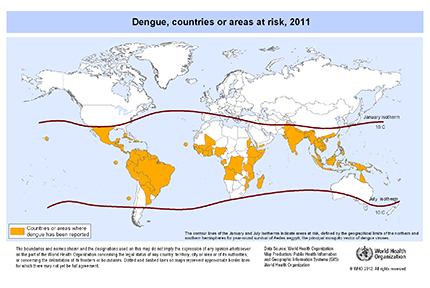
Source: www.humanosphere.org
With the current dengue outbreak being the worst since 2010, deaths from this dangerous disease have reached 25 from more than 12,000 people infected. The four fold increase in rates from last year shows this years outbreak reaching worrying heights. A number of measures are being taken to try and contain the outbreak and stabilise numbers as the year progresses. These include the use of BTi for the first time in Malaysia by the MoH and local councils in fogging programs, the continuing development of a tetravalent vaccine that’s in the late stages of clinical trials. A concerted effort on multiple platforms including social media has also helped raise awareness about this current epidemic. It has brought more focus on this issue and ways we all can help to control this outbreak. The question we have to ask is what consequences does this current outbreak have for us in the future in terms of the general health of society as a whole.
It is best to consider this issue from a number of levels starting with the most macroscopic of outlooks, moving in. With current climate change patterns and continuing urban development, dengue infection rates are projected to increase as habitable environments for the vector aedes mosquito continue to grow. Projections as far out to the year 2085 show an estimate of 5-6 billion people (50-60% of the global population of the time) would be at risk of dengue transmission compared to 35% if climate change does not occur, and 40% at present.
These projections show us that these outbreaks could become more frequent and sizeable over the coming years. They could also become far more critical in terms of deaths considering the rising number of comorbidities from non communicable diseases and an ageing population. From this perspective we are only to expect the worst is yet to come.

Source: http://www.themalaysianinsider.com/
But with the advent of vaccinations being available in the near future and better tools to help detect and prevent adverse outcomes of the disease, one can hope we get a better handle on the issue and control of outbreaks in the future. The current vaccine that is in the latter stages if clinical trials could prove crucial in addressing outbreaks concerning the relevant strains if dengue that it helps deal with. However, we have little perspective on the virulence this disease poses in the future and how it reacts to the presence of a vaccine being available in the community. With new strains such as the den-5 strain being detected as late as 2007 coming to the fore, we could only be looking at a medium term solution to these issues. Public health measures that have been in place for years continue to be amongst our most crucial tools in fighting outbreaks. These include routine use of insecticides by local councils, and awareness campaigns regarding the breeding sites of aedes mosquitoes. Comparing our efforts with our neighbours show certain countries being better equipped at dealing with outbreaks. Countries like Vietnam and the Philippines showing better concerted public health efforts in controlling vector breeding. Some have attributed these achievements to stricter control measures and implementation of enforcement. The lack of responsibility to abandoned building sites, and vacant land lots in Malaysia could possibly account for poor control of breeding sites. This should also make us question how future urban development, urban poverty and general social well being of urbanites could affect the pattern of future outbreaks. The economic climate of the country and particular urban regions could also affect how well our government is able to combat outbreaks and implement the necessary measures and bear the burden of this disease alongside that of non communicable diseases which is on the rise. This double burden of disease could pose further fractures to a health system already facing a plethora of issues from workforce, to infrastructure.
The question posed before us is where do we go from her? How do we enhance the positive effects of measures we can take while also reducing the harm of negative effects we foresee as mentioned? To tackle the issue would require a great effort by parties from the national government as a whole ensuring progress doesn’t leave us vulnerable to the above mentioned circumstances, to smaller communities ensuring the needs of its members don’t go unaddressed leaving them susceptible to the greater effects of this double burden. The task at hand poses many a challenge. A challenge all current and future health professionals need to rise above. A challenge all citizens of not just our country, but the region at large needs to undertake. Are we to succeed in our endeavours, or are we to become mere victims of circumstance?
Dilip Jayasimhan a 5th year medical student at the University of Auckland.
This is the personal opinion of the writer and does not necessarily represent the views of The Malaysian Medical Gazette.

Thanks.good info.